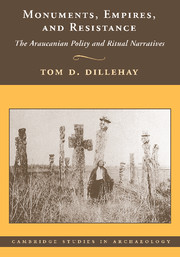Book contents
- Frontmatter
- Contents
- Figures
- Preface
- INTRODUCTION
- PART ONE PROSPECTS AND PATTERNS
- ONE PURPOSES, SETTINGS, AND DEFINITIONS
- TWO SHAPING ANALOGICAL AND CONCEPTUAL PERSPECTIVES
- THREE ARAUCANIAN PREHISTORY AND HISTORY: OLD BIASES AND NEW VIEWS
- FOUR IMBRICATING SOCIAL, MATERIAL, METAPHORICAL, AND SPIRITUAL WORLDS
- FIVE THE ETHNOGRAPHIES OF KUEL, NARRATIVES, AND COMMUNITIES
- SIX AN ARCHAEOLOGICAL VIEW OF KUEL AND REHUEKUEL
- PART TWO ANALYSIS AND INTERPRETATION
- Appendix One Ethnographic Ritual Narratives at Hualonkokuel and Trentrenkuel
- Appendix Two Radiocarbon Dates and Thermoluminescence Dates
- References Cited
- Index
SIX - AN ARCHAEOLOGICAL VIEW OF KUEL AND REHUEKUEL
Published online by Cambridge University Press: 27 July 2009
- Frontmatter
- Contents
- Figures
- Preface
- INTRODUCTION
- PART ONE PROSPECTS AND PATTERNS
- ONE PURPOSES, SETTINGS, AND DEFINITIONS
- TWO SHAPING ANALOGICAL AND CONCEPTUAL PERSPECTIVES
- THREE ARAUCANIAN PREHISTORY AND HISTORY: OLD BIASES AND NEW VIEWS
- FOUR IMBRICATING SOCIAL, MATERIAL, METAPHORICAL, AND SPIRITUAL WORLDS
- FIVE THE ETHNOGRAPHIES OF KUEL, NARRATIVES, AND COMMUNITIES
- SIX AN ARCHAEOLOGICAL VIEW OF KUEL AND REHUEKUEL
- PART TWO ANALYSIS AND INTERPRETATION
- Appendix One Ethnographic Ritual Narratives at Hualonkokuel and Trentrenkuel
- Appendix Two Radiocarbon Dates and Thermoluminescence Dates
- References Cited
- Index
Summary
This chapter provides a synopsis of the architectural archaeology of mound cultures in the Purén and Lumaco Valley, relates the chronological and spatial patterning of this record to the ethnography and ethnohistory reported earlier, and presents a broader, more scholarly analytical perspective of the sacred geographies of kuel and rehuekuel as a form of Araucanian monumentalism. More archival, chronological, and functional research is required to better understand these cultures and their formation processes, to relate kuel and rehuekuel to specific lineages and leaders named in the texts, and to infer lineage and polity development in the south Andes. Since this chapter is a preliminary report on the archaeology and its broader social and landscape meaning, the methodology is only briefly discussed.
Prior research in south-central Chile suggests a singular picture of late pre-Hispanic and early Hispanic Araucanian culture, which consisted of decentralized settlement of dispersed households occupied by kin-based group of chiefs and commoners (Dillehay 1976, 1990a, 1990b; Aldunate 1989; see Chapter 3). Settlements were supported by various combinations of cultigens, hunting, gathering, and fishing. The idea of a singular Araucanian pattern gives way on closer inspection to a regionally varied group of dispersed and nucleated settlements incorporated through local historical contexts and linked through shared cultural tendencies and widely held belief systems. Some areas developed nucleated settlements associated with isolated mound building, incipient agriculture, public rituals, and partly centralized leadership in rich and geographically circumscribed valleys (i.e., Purén, Lumaco, Liucura, Tucapel, Arauco, Villarrica).
- Type
- Chapter
- Information
- Monuments, Empires, and ResistanceThe Araucanian Polity and Ritual Narratives, pp. 275 - 332Publisher: Cambridge University PressPrint publication year: 2007

